Oberlin Alumni Magazine
Summer 2008 Vol. 103 No. 4
Cheryl Hummon’s Bike Journal
April – October, 2007
Total miles touring: 8,674
Total riding days: 154 (145 riding days + 9 days off), including:
With UGRR group: 48 (41 riding days + 7 days off)
Solo: 50 (50 riding days + 0 days off)
With Meg/Mom: 56 (54 riding days + 2 days off)
Ave. miles per riding day: 60
Number of Flats - Cheryl: 4 (1 bike and 3 trailer)
Number of Flats – Meg/Mom: 1 (1 trailer)
Overview of Entire Trip
I arranged for a two-month leave from my job in Portland, Ore., with the Defenders of Wildlife, a national nonprofit organization, and signed on with the inaugural self-supported group on Adventure Cycling Association’s new Underground Railroad (UGRR) Bicycle Route. Since the UGRR trip was seven weeks long, I had an opportunity to add 1.5 weeks of biking. I invited my mother, Meg Hummon, to fly to Toronto and ride with me back to Athens, Ohio, where she and my father live. When we got near Athens, I tried to accept that the trip was over, and prepare mentally to return to Oregon and to my job. Then I had a crazy idea: here I am in Ohio, 4,000 biking miles from home, with my bike and gear, and the whole summer in front of me! I made a difficult decision to quit my job and ride back to Oregon, mostly alone. Mom flew to Missoula and rode with me from there to Portland. I was in Portland for 10 days. Then mom and I spent October riding down the California coast. When I returned to Portland, I began a job search.
Underground Railroad (UGRR) Bicycle Route
Cheryl with ACA Self-Supported Group
April 13 – May 30, 2007
2,452 miles
48 days (41 riding days + 7 days off)
Average 58 miles per riding day
0 Flat Tires
Summary: The Adventure Cycling Association, based in Missoula, Mont. in close partnership with the Center for Minority Health in Pittsburgh, Pa., developed the route. Because we were the inaugural group, we faced several unusual circumstances: community events, media coverage, beta-testing the new bike maps, and riding where cycle touring was completely unknown. We also were an unusually large group, with up to 18 riders (including two leaders), which made group dynamics and logistics complex. It was a challenging trip, but nothing like what slaves trying to escape endured.
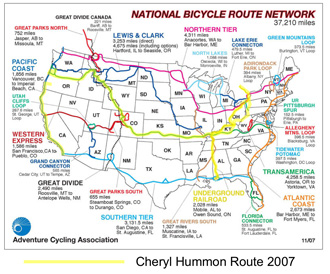
Starting Out
I flew to Mobile, Ala. From Portland, Ore., after 12 hours at work and a night with no sleep. I put my bike and trailer together at the airport and rode 20 unfriendly miles to the Adventure Cycling meeting place, where group gear was distributed.
After we ceremonially dipped our bicycle wheels in the Mobile Bay, we headed to Africatown, a place settled by former slaves who were brought to Mobile not long before the Civil War. In the morning, a chilly headwind greeted us as we rode east across Mobile Bay, where I saw signs of Hurricane Ivan’s destruction of gas stations, hotels, and restaurants in 2004. In camp, I helped Norm, a nurse at the University of Pittsburgh’s St. Margaret’s Hospital, and another fellow biker figure out their new camping gear, since it was similar to mine. While the rest of the group took an unpaved shorter route, Norm and I rode to Jackson, seeking a library for e-mail. While there, a Jackson newspaper interviewed us. A front-page article and photo were published sometime later in their weekly paper. At the Army Corps campground in Coffeeville, we crossed the Tombigbee River.
I woke at 2 a.m. to a fast-moving, gallon-sized critter bashing through the bushes, then colliding with my tent, a foot from my head. I couldn’t figure out what critter it could be, until Alvin (the group leader, and an expert on all things southern) said that armadillos can run fast. Later I found four sets of rips and punctures aligned with the claws of its four feet, and decided it was time for a new tent. We rode into Linden, so our leaders Alvin and Joy could arrive early for the community events. Ron wasn’t feeling well, so after riding slowly with him for 10 miles, I facilitated getting him a ride from a driver in a pickup truck. The Linden police provided a blue-light escort into and out of town, and the community rolled out the red carpet for us. It took us seven days to travel through Alabama.
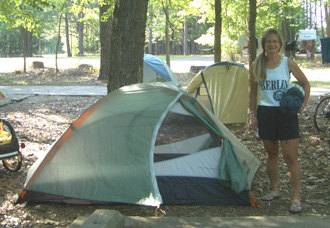 Cheryl is holding old tent, which has some tears from an armadillo colliding with it, several nights earlier. Her new tent is to the left.
Cheryl is holding old tent, which has some tears from an armadillo colliding with it, several nights earlier. Her new tent is to the left.
Mississippi (3 days)
Hilly terrain continued, and we had several days of high humidity and warm rain ahead of us. The route generally followed the Tenn-Tom Waterway, a canal between the south-flowing Tombigbee River and north-flowing Tennessee River. The day we entered Mississippi, I lagged behind to figure out how to order a new tent and get it delivered to our campground. I ended up far behind the group, and crossed the state line alone. My bike’s odometer hit 30,000 miles that day, a major milestone for me. The new tent arrived as planned during our day off in Aberdeen, and fellow rider Harvey helped me set it up. Norm’s front panniers arrived with the tent, but since his front rack wouldn’t come for several days, I carried the empty panniers in my trailer. We rode along the Nachez Trail Parkway, a 400-mile historical road that’s worth a separate bike trip! At Tishomingo State Park, I finally found my first post cards of the trip. On bike trips, I normally send frequent postcards to friends and family. I had been disappointed, but not surprised, to find no post cards in these non-touristy, rural areas.
Tennessee (4 days)
The Tennessee border is marked only by a change of pavement and a rusty, almost illegible government survey marker. Not far into Tennessee, I saw my first green bike route sign of the trip. The hilly terrain continued. Alvin and I jury-rigged Norm’s new front rack, which turned out to be the wrong one for his bike. We traveled through Shiloh, and further north to Ft. Donelson, both famous Civil War sites with northern victoriesand into Saltillo. In Tennessee, and northward into Ohio, it looked like fall because there had been a spring frost hard enough to kill all the new leaves. As we rode north, and as time passed since the severe frost, we eventually rode past bushes and trees that were producing their second set of spring leaves. Despite my natural resources career, I didn’t know trees could do that!
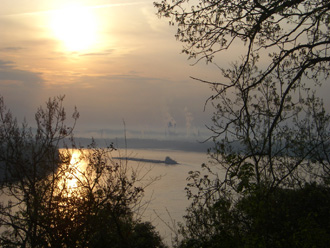 Ohio River with fog, coal barge, and coal plant (from cliffs near Henderson, Kentucky)
Ohio River with fog, coal barge, and coal plant (from cliffs near Henderson, Kentucky)
Kentucky (and a Little Illinois/Indiana) (9 days)
We entered Kentucky in the Land Between the Lakes, an interesting federal recreation area that lies between the Cumberland and Tennessee rivers. After about two weeks on the road, we had our second day off in Grand Rivers, a little town with a very supportive bike shop and other amenities for recreational tourists. By this time, Ron, a cyclist, left us because of health problems. But still we plugged onward, crossing the Ohio River into Illinois by ferry for one night at Cave-In-Rock. There, a local cyclist arranged for some high quality treats for us: wine, fruit, chocolate, a singer, and a historian. He also brought Dippin’ Dots ice cream, a favorite of mine. When we crossed back into Kentucky the next day, we were in Amish country.
As the hilly terrain continued, I noticed that uphill sections had marks on the pavement where the horses dug their nails in to grip, while downhill sections showed marks on the pavement from both horse hoof nails and buggy wheel skid-marks. Our route generally followed the Ohio River along the western then northern border of Kentucky, although the route went up and down hills more than it followed flat floodplains. Stephen and Mario, director and staff from the Center for Minority Health in Pittsburgh, joined us for a week in Kentucky and into Ohio. It was a very hard week of unending hills, a big thunderstorm, and an extreme downpour that dumped several inches of water in 45 minutes. When conditions were tough, I sometimes reflected on the enormously greater challenges faced by escaping slaves. The route took us into Indiana for a few days. There, we visited a museum housed in the old Carnegie Library in New Albany, to see their underground railroad exhibit, which was very moving and sobering.
Washington, Kentucky, had a lot of slavery and anti-slavery history, including Harriett Beecher-Stowe observing a slave auction that she later wrote about in her famous book, Uncle Tom’s Cabin. About half of our group wandered around in Washington reading historical signs, and several went on a guided tour. Harvey had a flat on his rear tire, so Steve and I decided to skip the tour, to secretly fix it. When Harvey got into camp, he found me, got down on one knee, and kissed my hand in gratitude.
As we approached Ohio, the terrain remained hilly, but instead of going up and down hills, we rode along ridges and dropped down then back up again, to cross creeks. It was nice to be up high and see long distances. In this terrain, near the tiny town of Sparta, Kurt (an experienced cycle tourist) hit a dog that ran out unexpectedly, and crashed. The local community assisted immediately, and Kurt was taken to Cincinnati with a broken shoulder and pelvis (broken in seven places).
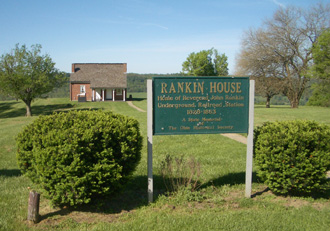 House of abolitionist John Rankin, looking out over miles and miles of the Ohio River (Ripley, Ohio).
House of abolitionist John Rankin, looking out over miles and miles of the Ohio River (Ripley, Ohio).
Ohio (13 days)
We crossed the Ohio River from Maysville, Kentucky to Aberdeen, Ohio. Then we rode seven flat miles to Ripley, where we had a day off. The Ripley community rolled out the red carpet in an unmatched way. They arranged a huge dinner with dozens of locals, a community ceremony, laundry, tune ups for our bikes, massages, and much more. My sacro-iliac joint and lower back were very unhappy from all the hills, so I welcomed the free massage!
We spent part of the day touring two significant UGRR sites: John Rankin’s house and John Parker’s house by the river. It was a great feeling to finally be on the north side of the Ohio River. We were finally where slaves escaped TO rather than FROM.
My parents drove from Athens, Ohio, to visit, and mom rode with us the next day. Mom loaned Harvey a tire, since his rear tire had developed a huge gash and was on its last leg. Dad drove the car that day, and took the cooks from the campground to the store for groceries (a service that we often could arrange from campground hosts or other locals). For our ride into Cincinnati, we were joined for a Freedom Ride by community members, staff from the Underground Railroad Freedom Center, and bike club members for a Freedom Ride. We had special permission to camp on the lawn in front of the Underground Railroad Freedom Center in downtown Cincinnati. We waved at the security cameras and were allowed into a service entrance of the center to shower and use the restroom. We had a day off and spent most of it in the center, and we also did errands. Two volunteers schlepped carloads of us to visit Kurt in the hospital and buy him some street clothes and non-cycling items. He was far from family and happy to have visitors. After we left Cincinnati, local cyclists and community members continued to visit Kurt until he headed home weeks later.
We rode north on the Little Miami rails-to-trails path, and visited Wilberforce College and its Afro-American Museum and Cultural Center. In Delaware, the campground had vicious raccoons that fought all night and jumped on the lids of the 55-gallon drum garbage containers until the lids flipped off and they could get at the trash. The animals also attacked our huge food bag that the cooks had stashed in an empty can. Ken had to get up in the middle of the night to haul the garbage and the food bag to the safety of the restroom.
We had another day off when we arrived in Oberlin, where we had tours of anti-slavery homes and sites. I also visited with former professors and co-workers. However, after our enjoyable stay in Oberlin, another sobering incident befell our group. As the route passed north of Akron, George was hit by an SUV at a dangerous intersection and suffered a trip-ending broken shoulder. The car swerved to miss him and flipped into the ditch. Our group, shaken but steadfast, reached Lake Erie in Ashtabula, where the Hubbard House had been the departure point for slaves escaping north across the lake to the freedom and safety of Canada.
Pennsylvania/New York (3 days)
We rode along Lake Erie through Erie County, Pa., and stopped at the Erie Public Library to join their community cycling event. They had food and a private room for us, including Internet access, plus bike-related displays and a public event timed to encourage local cycling. We had a screaming tailwind as we reached the border. There, we met cyclists participating in America By Bicycle’s first springtime cross-country ride. On this supported ride, cyclists ride 120 miles per day! In New York, heavy rain greeted us as we approached Buffalo, but fortunately we had decided to spend some extra group funds on hotel rooms that night. A few days later, after Niagara Falls, we dipped back into New York to visit Murphy Orchard, home of an abolitionist who hid slaves and helped them get into Canada. They had produced an excellent video about the financial and political context of slavery, conditions slaves encountered on their journeys, and the role of Murphy Orchard specifically.
Ontario (9 days)
We entered Canada by crossing the Peace Bridge from Buffalo to Fort Erie, and spotted a safe-house that hid slaves who had crossed the border. We rode north along a bike path that follows the Niagara River to Niagara Falls. We had a day off there and split into smaller groups to see the sights. I headed out along Lake Ontario on a side-trip to Burlington to order new trailer tires. On my way back along the lakefront, the skies opened with a torrential downpour and I hid on the lea side of a pub until water started pouring off the roof onto me. Then Ken and Harvey showed up drenched and we all gave up, went inside, and had a drink. Harvey, a 76-year-old retired physician, had just crashed on the bike path to avoid hitting a little kid who darted out, and thought he had cracked a rib or two. He would not seek diagnosis or treatment, and rode the last four days of the trip in significant pain. When he got home, the diagnosis was several broken ribs.
We rode up on the Niagara Escarpment for most of two days, going from Lake Ontario to Lake Huron. The plateau has a bizarre patchwork of roads that are not on the N-S-E-W grid, and intersecting roads are consistently about 83 degrees apart, not at right angles (was the planner drunk?). We passed an area with huge power-generating windmills, riding into a stiff chilly wind. This far north, spring was not as far along, and we were back into lilacs in full bloom. We first got to the Georgian Bay of Lake Huron near Collingwood. We rode west about 20 miles on the Georgian Trail, which had a crushed limestone surface smooth enough for my skinny 23mm road tires. For the last day of riding, Mario rejoined us, to represent the Center for Minority Health for the end-of-trip festivities in Owen Sound. Most riders stayed together all day, whereas on most days, people rode in groups of two to four. We stopped at the Grey Roots Museum, where we learned about the history of escaping slaves settling in Owen Sound and the evolution of a truly integrated community. In Owen Sound, we set up camp for the last time, in a city park just south of town. In the mid afternoon, UGRR riders and many locals, including the mayor, gathered at the park to ride a few miles to the waterfront for our ceremonial wheel dipping in Lake Huron’s Owen Sound. A town crier made various formal proclamations, the mayor and other local dignitaries gave speeches, and we all shared a community dinner. It was a glorious celebration, and a fitting end to the trip. The UGRR riders wrapped up with a final meeting, reflecting on our journey north together.
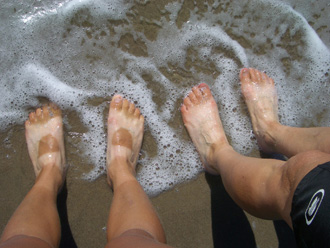 Cheryl and Mom’s toes (with cycling sandal tan-lines) take a dip in the chilly Pacific near Gaviota, Calif.
Cheryl and Mom’s toes (with cycling sandal tan-lines) take a dip in the chilly Pacific near Gaviota, Calif.
Riding With Mom
Toronto, Ontario to Athens, Ohio
Cheryl and Mom (Meg Hummon)
May 31 - June 11, 2007
652 miles
12 days (12 riding days + 0 days off)
Average 54 miles per riding day
0 Flat Tires (Mom had one flat on her trailer)
Cheryl: Mom turned 70 in 2007. She started riding long distances just five years ago, chasing the bike adventures I was having. Since then, we completed several supported trips (e.g. Cycle Oregon). In 2005, we rode self-supported down the Washington/Oregon coast for three weeks. For self-supported trips, I ride my carbon-frame Trek, and pull my Burley Nomad trailer – a setup that is flexible enough that I can carry mom’s gear in addition to mine (I am "Sherpa Daughter"). Mom and I were "Team Tortoise," slow and steady. Mom can ride 50 miles per day if I carry her gear. The less she carries, the faster she goes!
Meg: Since Cheryl was on the UGRR ride, trip planning for Toronto to Athens was up to me. It was a frustrating learning experience, but fun. It took a lot of time, but the results worked out pretty well. A first for me was to fly into the Toronto airport with my gear in a soft duffle and Chippy, my folding bike, in its suitcase. I found a quiet corner at the airport, assembled the bicycle, transformed the suitcase into a trailer, put the duffle and gear in the trailer, and rode 20 miles to meet Cheryl at a downtown hostel. This trip was also a first for me towing the trailer. I now routinely use it for farmer’s market and grocery shopping in Athens, Ohio. We backtracked along the UGRR route for about four days. Then split off in the western edge of New York to head south into hilly Pennsylvania. That was the toughest and slowest part of the trip for me. During this section of the ride I averaged 7.5 mph. After that, we decided to avoid the hills of eastern Ohio, and ride along the Ohio River.
Editor’s note: After Cheryl and her mom made the trek from Toronto, Ontario, to Athens, Ohio, Cheryl resigned from her job and spent the next four months biking west through 12 states, including Wyoming, Montana, Idaho, and Oregon (following the Trans Am bicycle route), plus the California coast. Since riding west was a last-minute decision, she had no way to recruit a riding partner and rode solo most of the time from Athens to Missoula, Mont. Her mom rejoined her for Missoula and the California coast. She had to push the pace to Denver, with no days off to fly back to Ohio for a family reunion. The average daily miles were more than she preferred, especially in conditions featuring the 4 H’s (heat, humidity, headwinds, and hills). As a woman riding alone, she had to think about personal safety. She was not comfortable carrying or using weapons, mace, or pepper spray, and instead focused on avoiding trouble. Her mom knew her itinerary and she checked in with her every day. She also kept her cell phone on and avoided sharing details of her plans or circumstances with strangers. She only camped when she ran into other cyclists who were camping. In all, Cheryl racked up more than 8,000 miles before returning home to Portland, Ore.
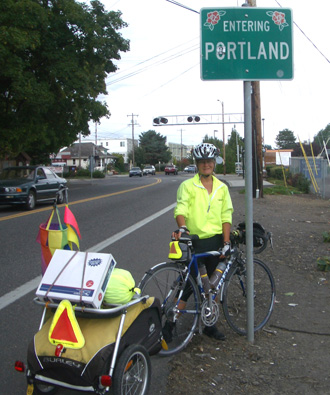 Cheryl arrives home after five months on the road
Cheryl arrives home after five months on the road
Epilogue
November 2007 – February 2008
Portland, Ore.
I began my job search in late September between the Trans Am and California parts of the trip. I applied for several jobs during that 10-day break plus during the California trip. In November, when I returned to Portland, I entered a full-blown job search. I applied for more than 15 jobs. No offer was forthcoming until mid-February. The application I worked on during a day off in Santa Cruz, Calif., bore fruit, after a third interview. I accepted the position of director at the Northwest Zoo & Aquarium Alliance. The alliance promotes collaboration between zoos and aquariums for regional conservation efforts. I still live in Portland, where my position is housed at the Oregon Zoo. I work with eight northwest zoos and aquariums, and maximize my use of bike and train for work travel. While I have no concrete plans for another long bike trip, I am always plotting and planning the next vacation-length bike trip, and fantasizing about a long trip for my 50th birthday in about five years.
